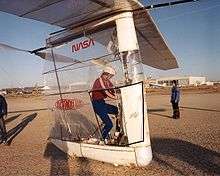MacCready Gossamer Albatross
| Gossamer Albatross | |
|---|---|
 | |
| The Gossamer Albatross II at Dryden Flight Research Center in 1980 | |
| Role | experimental aircraft |
| National origin | United States |
| Manufacturer | AeroVironment |
| Designer | Paul MacCready |
| First flight | 1979 |
| Status | Gossamer Albatross I - Steven F. Udvar-Hazy Center, Virginia, USA Gossamer Albatross II - Museum of Flight in Seattle, Washington, USA |
| Number built | 2 |
| Developed from | Gossamer Condor |
| Developed into | Gossamer Penguin |
The Gossamer Albatross is a human-powered aircraft built by American aeronautical engineer Dr. Paul B. MacCready's company AeroVironment. On June 12, 1979 it completed a successful crossing of the English Channel to win the second £100,000 (£456260 today) Kremer prize.[1]
Design and development
The aircraft was designed and built by a team led by Paul B. MacCready, a noted American aeronautics engineer, designer, and world soaring champion. Gossamer Albatross was his second human-powered aircraft, the first being the Gossamer Condor, which had won the first Kremer prize on August 23, 1977 by completing a 1 mi (1.6 km)-long figure-eight course. The second Kremer challenge was then announced as a flight across the English Channel recalling Louis Blériot's crossing of 1909.
The aircraft is of "canard" configuration, using a large horizontal stabilizer forward of the wing in a manner similar to the Wright brothers' successful "Flyer" aircraft and powered using pedals to drive a large two-bladed propeller. The Gossamer Albatross was constructed using a carbon fiber frame, with the ribs of the wings made with expanded polystyrene; the entire structure was then wrapped in a thin, transparent plastic (mylar aka PET film). The empty mass of the structure was only 71 lb (32 kg), although the gross mass for the Channel flight was almost 220 lb (100 kg). To maintain the craft in the air it was designed with very long tapering wings (high aspect ratio), like those of a glider, allowing the flight to be undertaken with a minimum of power. In still air the required power was of the order of 300 W (0.40 hp), though even mild turbulence made this figure rise rapidly.[2]
The crossing

Just before 6 a.m. on June 12, 1979, amateur cyclist and pilot Bryan Allen, powered the Albatross to the rehearsed speed of 75 revolutions per minute and took off from a point near Folkestone, England. The Channel conditions and lack of wind were ideal for the crossing.
However, issues soon started to affect the aircraft and pilot. Allen's radio failed and he was only able to communicate with the accompanying boats via hand and head movements. Next, Allen's water supply had been estimated for a two-hour flight but headwinds delayed the crossing and his supply ran out. Without adequate water, Allen suffered from dehydration and leg cramps. On-board instruments were also affected by the extension to flight time, with the batteries for the airspeed instruments and acoustic altimeter failing, so Allen no longer knew his height or airspeed.
With increasing headwinds there was concern that the flight would have to be called off. With the coast of France still unseen, an accompanying boat maneuvered in front of the Albatross to hook it to safety. However, during this time, Allen had gone a little higher and found there was less air turbulence and he continued to pedal the aircraft and see if progress could be made. With a calming surface wind, Allen continued onwards and landed on a beach at Cape Gris-Nez in France. Allen completed the 22.2 mi (35.7 km) crossing in 2 hours and 49 minutes, achieving a top speed of 18 mph (29 km/h) and an average altitude of 5 ft (1.5 m).[3]
Versions
MacCready's team built two Albatrosses; the back-up plane was jointly tested as part of the NASA Langley/Dryden flight research program in 1980 and was also flown inside the Houston Astrodome, the first ever controlled indoor flight by a human-powered aircraft. The Albatross II is currently on display at the Museum of Flight in Seattle, Washington.
Alistair Cooke devoted some of his Letter From America broadcast of 15/17 Jun 1979 to Allen's achievement.
Prizes
For his work on the Gossamer Albatross, Dr. Paul MacCready was later awarded the Collier Trophy.[1]
Specifications (Gossamer Albatross)

Data from MuseumofFlight.org[4]
General characteristics
- Crew: 1
- Length: 10.36 m (34.0 ft.)
- Wingspan: 29.77 m (97.7 ft.)
- Height: 4.88 m (16.0 ft.)
- Wing area: 45.34 m2 (488 ft2)
- Empty weight: 32 kg (70 lb)
- Useful load: 65.5 kg (145 lb)
- Loaded weight: 97.5 kg (215 lb)
Performance
- Maximum speed: 28.97 km/h (18 mph)
- Range: 56.33 km (35 miles)
See also
- Related development
- Aircraft of comparable role, configuration and era
Notes and references
- 1 2 "Gossamer Albatross ECN-12665". NASA. Retrieved March 26, 2015.
- ↑ "Gossamer Albatross". Smithsonian National Air and Space Museum. Retrieved March 26, 2015.
- ↑ "Gossamer Albatross". AeroVironment, Inc. Retrieved March 26, 2015.
- ↑ MuseumofFlight.org, Referenced May 19, 2010
Further reading
- Allen, Bryan. Winged Victory of "Gossamer Albatross". National Geographic, November 1979, vol. 156, n. 5, p. 640-651
- Morton Grosser. Gossamer Odyssey: The Triumph of Human-Powered Flight. MBI Press, 2004; Dover Publications, Inc., 1991; Houghton Mifflin Co., 1981
- Morton Grosser. On Gossamer Wings. York Custom Graphics, 1982
- Ciotti, Paul. More With Less - Paul MacCready and the dream of efficient flight. Encounter Books, 2002. ISBN 1-893554-50-3
External links
| Wikimedia Commons has media related to Gossamer Albatross. |
- NASA's page on Gossamer Albatross II
- NASA image of Gossamer Albatross II
- List of displayed aircraft at Udvar-Hazy center
- Gossamer Albatross II at Seattle Museum of Flight
- Shows various MacCready & Aerovironment aircraft, including Gossamer Penguin
- Gossamer Albatross photography by the team's photographer, Don Monroe
- Solar Challenger photography
- Actual Video Footage of Gossamer Condor and Albatross